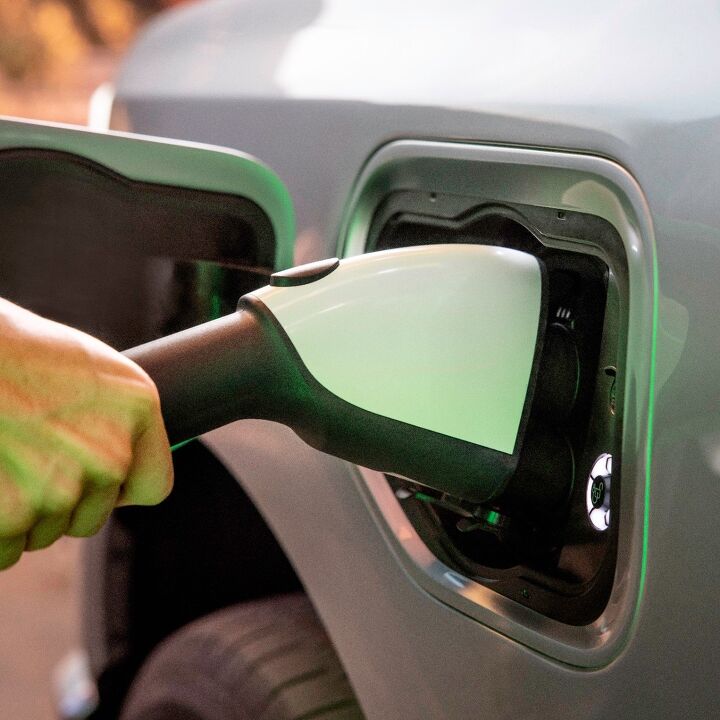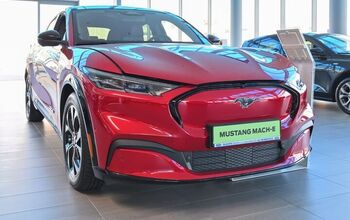NY Judge Pauses Ford’s EV Dealer Requirements

A New York judge has halted Ford and Lincoln from instituting a specific set of requirements before allowing dealerships to sell the brands’ all-electric vehicles. This comes after five stores operating within the state launched a lawsuit against Ford Motor Co. for introducing a new certification process for EVs. The issue was that the automaker was asking too much from dealerships and effectively favoring those with deeper pockets by forcing changes that required significant financial investments.
Ford introduced its tiered dealer program nearly twelve months ago, splitting stores interested in selling electric into “Model e Certified Elite” and “Model e Certified.”
The former required an investment of roughly $900,000 for the installation of two DC fast chargers and some tweaks to ensure customers see them and can tell the location is able to sell EVs. It also requires an additional investment of $300,000 to have a third charger installed by 2026. In exchange, dealers are given access to demo vehicles and a factory guarantee for limited EV allocations.
Meanwhile, Model e Certified stores needed to drop $500,000 on a single charger that’s publicly visible. Those dealerships are likewise given the ability to sell Ford and/or Lincoln EVs. But they are not guaranteed allocations nor any demo models.
While stringent dealer requirements are nothing new from the industry, they also have a tendency to backfire. Demanding dealers to make sizable investments can help improve the customer experience and help move product. But asking for too much can likewise mean offending the people that move said product.
For example, Cadillac’s Project Pinnacle resulted in years of conflict between General Motors and dealer networks — forcing the scheme to undergo repeat changes as stores simply dropped out. GM had simply asked for too much and only saw showrooms playing ball after repeat revisions. These things are commonplace and finding the balance between necessary and overbearing change can be difficult.
Something like the above may actually work out okay for Lincoln. With the brand shrinking, Blue Oval has been hoping to reduce the number of dealerships while instituting a limited number of standalone boutique retail experiences. Lincoln is hoping to focus on creating a desirable, upscale atmosphere and treating customers exceptionally well — separating itself from the core brand both physically and spiritually.
Shifting back to Ford, the company was distressed that dealerships were putting such ludicrously high markups on its EVs as they came to market. By forcing an investment, Blue Oval was presumably trying to weed out which stores were serious about selling EVs and which simply wanted to cash in while they were hard to source. Part of Ford’s new certification process also requires dealerships to agree to fixed pricing.
Overpriced automobiles have become a serious problem in recent years, with dealers frequently adding thousands to in-demand or low-volume models. However, the issue seems to be solving itself as an ailing economy means fewer people can afford new vehicles. Still, Ford wants some guarantee that dealers selling electric cars are seriously committed to offering them long term and in a manner that reflects well on the brand.
Ford has said the program would be entirely voluntary, adding that dealers could opt-in to the EV certification programs later on. This was also the argument it used in court, adding that out of spec dealerships can still sell everything else in Ford’s lineup.
Truth be told, it probably won’t have been an issue in most other states. But New York law stipulates that dealerships demanding a review of any agreement modifications require a mediation process before it can come into effect.
New York's Franchised Motor Vehicle Dealer Act simultaneously forces companies to provide their dealers with at least 90 days of notice before making changes to the agreement. In the case of requests that would physically change the facility, 180 days are required. All five plaintiffs going against Ford have said they were given insufficient notice on the latter item as it pertains to EV fast chargers.
According to Automotive News, Suffolk County Supreme Court Acting Justice James Hudson ruled that Ford had adjusted its dealer relationship to prevent non-participating retailers from selling and servicing EVs that they were allowed to prior to the certification scheme.
"The question before the Court is not whether the Programs are 'reasonable' nor whether participation is 'voluntary,'" Judge Hudson explained. "Instead, the question before the Court is whether the effect of Ford's electric vehicle Programs modifies the franchise business relationship. Each states that a non-participating dealer may neither sell nor service Ford EVs. This is a significant change in the current business model."
The assumption is that dealerships that didn’t want to spend the money have effectively been forced out of selling an entire vehicle segment they previously had access to. We’ll have to wait and see how things progress in New York’s Suffolk County. But Ford’s defense that those shops can simply opt-in later has worked in legal disputes launched in other states.
[Image: Ford Motor Co.]
Become a TTAC insider. Get the latest news, features, TTAC takes, and everything else that gets to the truth about cars first by subscribing to our newsletter.

A staunch consumer advocate tracking industry trends and regulation. Before joining TTAC, Matt spent a decade working for marketing and research firms based in NYC. Clients included several of the world’s largest automakers, global tire brands, and aftermarket part suppliers. Dissatisfied with the corporate world and resentful of having to wear suits everyday, he pivoted to writing about cars. Since then, that man has become an ardent supporter of the right-to-repair movement, been interviewed on the auto industry by national radio broadcasts, driven more rental cars than anyone ever should, participated in amateur rallying events, and received the requisite minimum training as sanctioned by the SCCA. Handy with a wrench, Matt grew up surrounded by Detroit auto workers and managed to get a pizza delivery job before he was legally eligible. He later found himself driving box trucks through Manhattan, guaranteeing future sympathy for actual truckers. He continues to conduct research pertaining to the automotive sector as an independent contractor and has since moved back to his native Michigan, closer to where the cars are born. A contrarian, Matt claims to prefer understeer — stating that front and all-wheel drive vehicles cater best to his driving style.
More by Matt Posky
Latest Car Reviews
Read moreLatest Product Reviews
Read moreRecent Comments
- Bd2 Lexus is just a higher trim package Toyota. ^^
- Tassos ONLY consider CIvics or Corollas, in their segment. NO DAMNED Hyundais, Kias, Nissans or esp Mitsus. Not even a Pretend-BMW Mazda. They may look cute but they SUCK.I always recommend Corollas to friends of mine who are not auto enthusiasts, even tho I never owed one, and owned a Civic Hatch 5 speed 1992 for 25 years. MANY follow my advice and are VERY happy. ALmost all are women.friends who believe they are auto enthusiasts would not listen to me anyway, and would never buy a Toyota. They are damned fools, on both counts.
- Tassos since Oct 2016 I drive a 2007 E320 Bluetec and since April 2017 also a 2008 E320 Bluetec.Now I am in my summer palace deep in the Eurozone until end October and drive the 2008.Changing the considerable oils (10 quarts synthetic) twice cost me 80 and 70 euros. Same changes in the US on the 2007 cost me $219 at the dealers and $120 at Firestone.Changing the air filter cost 30 Euros, with labor, and there are two such filters (engine and cabin), and changing the fuel filter only 50 euros, while in the US they asked for... $400. You can safely bet I declined and told them what to do with their gold-plated filter. And when I changed it in Europe, I looked at the old one and it was clean as a whistle.A set of Continentals tires, installed etc, 300 EurosI can't remember anything else for the 2008. For the 2007, a brand new set of manual rec'd tires at Discount Tire with free rotations for life used up the $500 allowance the dealer gave me when I bought it (tires only had 5000 miles left on them then)So, as you can see, I spent less than even if I owned a Lexus instead, and probably less than all these poor devils here that brag about their alleged low cost Datsun-Mitsus and Hyundai-Kias.And that's THETRUTHABOUTCARS. My Cars,
- NJRide These are the Q1 Luxury division salesAudi 44,226Acura 30,373BMW 84,475Genesis 14,777Mercedes 66,000Lexus 78,471Infiniti 13,904Volvo 30,000*Tesla (maybe not luxury but relevant): 125,000?Lincoln 24,894Cadillac 35,451So Cadillac is now stuck as a second-tier player with names like Volvo. Even German 3rd wheel Audi is outselling them. Where to gain sales?Surprisingly a decline of Tesla could boost Cadillac EVs. Tesla sort of is now in the old Buick-Mercury upper middle of the market. If lets say the market stays the same, but another 15-20% leave Tesla I could see some going for a Caddy EV or hybrid, but is the division ready to meet them?In terms of the mainstream luxury brands, Lexus is probably a better benchmark than BMW. Lexus is basically doing a modern interpretation of what Cadillac/upscale Olds/Buick used to completely dominate. But Lexus' only downfall is the lack of emotion, something Cadillac at least used to be good at. The Escalade still has far more styling and brand ID than most of Lexus. So match Lexus' quality but out-do them on comfort and styling. Yes a lot of Lexus buyers may be Toyota or import loyal but there are a lot who are former GM buyers who would "come home" for a better product.In fact, that by and large is the Big 3's problem. In the 80s and 90s they would try to win back "import intenders" and this at least slowed the market share erosion. I feel like around 2000 they gave this up and resorted to a ton of gimmicks before the bankruptcies. So they have dropped from 66% to 37% of the market in a quarter century. Sure they have scaled down their presence and for the last 14 years preserved profit. But in the largest, most prosperous market in the world they are not leading. I mean who would think the Koreans could take almost 10% of the market? But they did because they built and structured products people wanted. (I also think the excess reliance on overseas assembly by the Big 3 hurts them vs more import brands building in US). But the domestics should really be at 60% of their home market and the fact that they are not speaks volumes. Cadillac should not be losing 2-1 to Lexus and BMW.
- Tassos Not my favorite Eldorados. Too much cowbell (fins), the gauges look poor for such an expensive car, the interior has too many shiny bits but does not scream "flagship luxury", and the white on red leather or whatever is rather loud for this car, while it might work in a Corvette. But do not despair, a couple more years and the exterior designs (at least) will sober up, the cowbells will be more discreet and the long, low and wide 60s designs are not far away. If only the interiors would be fit for the price point, and especially a few acres of real wood that also looked real.


































Comments
Join the conversation
I'm curious about the charger cost., $500,000 for a single charger? What am I missing here?
Uh, why are there franchise laws for individual states when there are vehicle super dealers selling in many states? Will the Your Home State Ford dealers be the next group to sue?